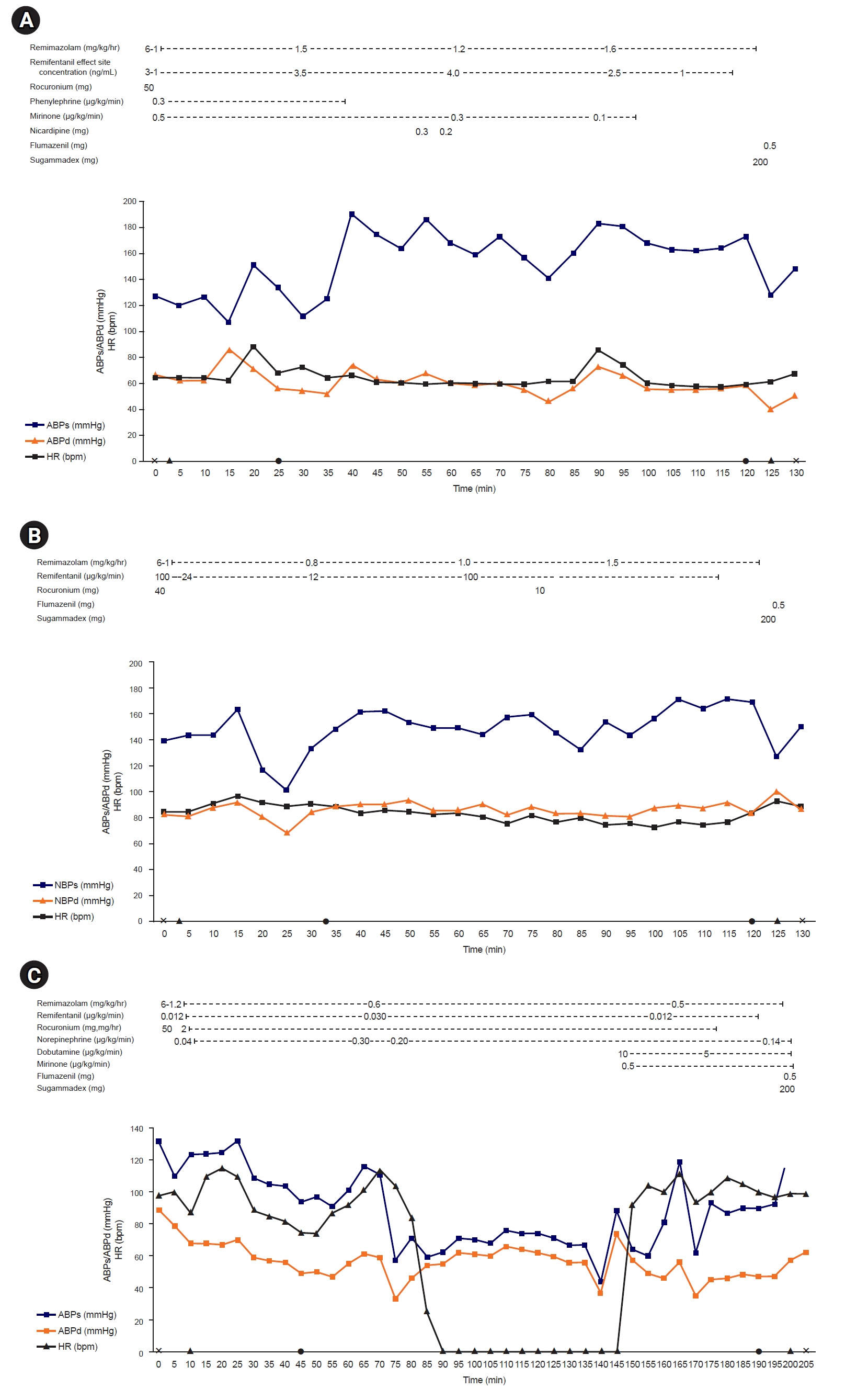Kosin Med J.
2024 Jun;39(2):144-149. 10.7180/kmj.23.156.
Total intravenous anesthesia using remimazolam for patients with heart failure with reduced ejection fraction: a case series
- Affiliations
-
- 1Department of Anesthesia and Pain Medicine, Pusan National University Yangsan Hospital, Yangsan, Korea
- 2Department of Anesthesia and Pain Medicine, Pusan National University School of Medicine, Yangsan, Korea
- KMID: 2556813
- DOI: http://doi.org/10.7180/kmj.23.156
Abstract
- Patients with heart failure undergoing surgery that requires general anesthesia face substantial perioperative risks; however, clear guidelines are not available for anesthesia management in patients with a reduced left ventricular ejection fraction. Traditional intravenous and volatile anesthetics require careful administration to prevent severe hypotension and bradycardia in patients with heart failure. Remimazolam has emerged as a promising alternative to conventional anesthetics because of its reduced cardiovascular depressive effects. We present three cases illustrating the successful use of remimazolam to induce and maintain general anesthesia in patients with heart failure and reduced cardiac function. Our cases demonstrate the safe use of remimazolam for general anesthesia in patients with heart failure and a reduced ejection fraction.
Figure
Reference
-
References
1. Smit-Fun V, Buhre WF. The patient with chronic heart failure undergoing surgery. Curr Opin Anaesthesiol. 2016; 29:391–6.2. Maile MD, Mathis MR, Jewell ES, Mentz GB, Engoren MC. Identification of intraoperative management strategies that have a differential effect on patients with reduced left ventricular ejection fraction: a retrospective cohort study. BMC Anesthesiol. 2022; 22:288.3. Doi M, Hirata N, Suzuki T, Morisaki H, Morimatsu H, Sakamoto A. Safety and efficacy of remimazolam in induction and maintenance of general anesthesia in high-risk surgical patients (ASA Class III): results of a multicenter, randomized, double-blind, parallel-group comparative trial. J Anesth. 2020; 34:491–501.4. Cheung CC, Martyn A, Campbell N, Frost S, Gilbert K, Michota F, et al. Predictors of intraoperative hypotension and bradycardia. Am J Med. 2015; 128:532–8.5. Tartiere JM, Logeart D, Safar ME, Cohen-Solal A. Interaction between pulse wave velocity, augmentation index, pulse pressure and left ventricular function in chronic heart failure. J Hum Hypertens. 2006; 20:213–9.6. Kanaya N, Murray PA, Damron DS. The differential effects of midazolam and diazepam on intracellular Ca2+ transients and contraction in adult rat ventricular myocytes. Anesth Analg. 2002; 95:1637–44.7. Satoh T, Nishihara N, Sawashita Y, Ohno S, Hirata N, Yamakage M. Remimazolam anesthesia for MitraClip implantation in a patient with advanced heart failure. Case Rep Anesthesiol. 2021; 2021:5536442.8. Furuta M, Ito H, Yamazaki M. Anaesthetic management using remimazolam in a patient with severe aortic stenosis: a case report. BMC Anesthesiol. 2021; 21:202.9. Nakanishi T, Sento Y, Kamimura Y, Tsuji T, Kako E, Sobue K. Remimazolam for induction of anesthesia in elderly patients with severe aortic stenosis: a prospective, observational pilot study. BMC Anesthesiol. 2021; 21:306.10. Schüttler J, Eisenried A, Lerch M, Fechner J, Jeleazcov C, Ihmsen H. Pharmacokinetics and pharmacodynamics of remimazolam (CNS 7056) after continuous infusion in healthy male volunteers: part I. pharmacokinetics and clinical pharmacodynamics. Anesthesiology. 2020; 132:636–51.11. Lohmer LL, Schippers F, Petersen KU, Stoehr T, Schmith VD. Time-to-event modeling for remimazolam for the indication of induction and maintenance of general anesthesia. J Clin Pharmacol. 2020; 60:505–14.12. Antonik LJ, Goldwater DR, Kilpatrick GJ, Tilbrook GS, Borkett KM. A placebo-and midazolam-controlled phase I single ascending-dose study evaluating the safety, pharmacokinetics, and pharmacodynamics of remimazolam (CNS 7056): part I. safety, efficacy, and basic pharmacokinetics. Anesth Analg. 2012; 115:274–83.13. Liu T, Lai T, Chen J, Lu Y, He F, Chen Y, et al. Effect of remimazolam induction on hemodynamics in patients undergoing valve replacement surgery: a randomized, double-blind, controlled trial. Pharmacol Res Perspect. 2021; 9:e00851.14. Doi M, Morita K, Takeda J, Sakamoto A, Yamakage M, Suzuki T. Efficacy and safety of remimazolam versus propofol for general anesthesia: a multicenter, single-blind, randomized, parallel-group, phase IIb/III trial. J Anesth. 2020; 34:543–53.
- Full Text Links
- Actions
-
Cited
- CITED
-
- Close
- Share
- Similar articles
-
- Optimal Management of Heart Failure with Preserve Ejection Fraction
- Prognostic Implications of Changes in Left Ventricular Ejection Fraction and Pulmonary Hypertension in Patients with Heart Failure with Reduced Ejection Fraction
- Total intravenous anesthesia with remimazolam in a patient with epilepsy who underwent deep brain stimulation: a case report
- Optimization of guideline-directed medical treatment for heart failure patients with reduced ejection fraction
- Heart failure with preserved ejection fraction: insights from recent clinical researches


